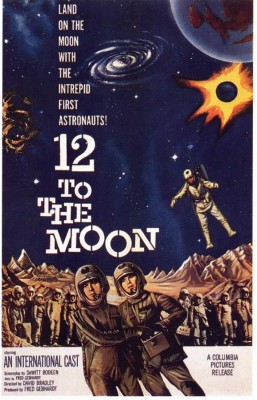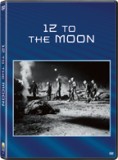| Reviews & Columns |
|
Reviews DVD TV on DVD Blu-ray 4K UHD International DVDs In Theaters Reviews by Studio Video Games Features Collector Series DVDs Easter Egg Database Interviews DVD Talk Radio Feature Articles Columns Anime Talk DVD Savant Horror DVDs The M.O.D. Squad Art House HD Talk Silent DVD
|
DVD Talk Forum |
|
|
| Resources |
|
DVD Price Search Customer Service #'s RCE Info Links |
|
Columns
|
|
|
12 to the Moon (Columbia Classics)
That it's just as awful as Bill describes is beside the point. Fans of various genres - Westerns, classic horror movies, film noir, etc. - don't expect every picture to hit a home run, or even make it to first base. Movies like 12 to the Moon are part of a larger tapestry of the Genre Experience - the sum of the parts being a reflection of that era, culturally, historically, and in terms of film history and audience tastes, providing nostalgic entertainment for some, enlightenment on a bygone age for others. Or maybe this review is just as clumsy and pretentious as 12 to the Moon inadvertently is.
Though its lunar expedition storyline is routine, hitting the usual clichés one-by-one (introduction of the crew, meteor shower, etc.) in fact the film is quite odd; its dozen characters may be shooting for the moon, but its writer and director clearly were aiming for the stars. If Stanley Kramer at his most pretentious were reduced to making a low-budget sci-fi film, the result might be something like this.
Presented in 16:9 enhanced widescreen in a pristine transfer on a DVD-R, 12 to the Moon looks just great. The movie may stink, but this surely is the way to see it. A 16:9 enhanced widescreen trailer is also included.
In notably clumsy exposition, the Director of International Space Order (former silent star Francis X. Bushman, now reduced to cameos in cheap films like this) introduces the international crew of the Lunar Eagle. Most, like Hideko Murata (Michi Kobi) and Sigrid Bromark (Anna-Lisa), have little to do beyond reacting to the story's increasingly outrageous machinations. The lion's share of the plot revolves around the actions of aloof Russian Feodor Orloff (Tom Conway, with strange accent); kindly but guilt-ridden German Erik Heinrich (John Wengraf); and his disciple in science, hotheaded Israeli David Ruskin (Richard Weber), whose Polish family was wiped out by the Nazis. In the kind of plot twist that only happens in the movies, Heinrich's father turns out to have been the Josef Mengele-like scientist who murdered Ruskin's family. Not counted among the 12 are a dog, a pair of cats, monkeys and some parakeets, good for some unintentionally funny cutaways, a la Tarzan's Cheeta.
The journey to the moon follows the well-worn path laid in films like Destination Moon and Rocketship X-M (both 1950). Once on the moon, however, strange things begin to happen. Bromark and her lover, Selim Hamid (Tema Bey), disappear into some mist and, later, are encased behind a great wall of ice. Another crewmember, Sir William Rochester (Phillip Baird), disappears into a quicksand-like trap of moondust.
Back at the ship, inexplicable symbols Hideko identifies as an "ancient Chinese dialect" (the characters don't look Chinese at all) that she's conveniently able to translate simultaneously turns out to be a message from Moon Men warning the crew to return to Earth at once. Fascinated by the emotion of love, they've decided to hold onto Bromark and Hamid, and further demand the earthlings leave behind the cats, which they find curiously appealing (!).
The movie itself gets curiouser and curiouser on the return trip, when the crew learns the Moon Men have put all of North America - but no other continent - into a "Big Freeze" as punishment for sending earthlings up at the moon uninvited. Sensibly (?), the crew decides to drop an atomic bomb in Mt. Popocatepetl, a volcano in Mexico, to reverse the process. (To what end? Defrost 300 million corpses?) However, despite everyone suspicions toward Orloff, Frenchman Etienne Martel (Roger Til) is revealed as the secret Commie saboteur, and he's not about to let this golden opportunity of a frozen North America come undone.
12 to the Moon was produced with the kind of money and time low-budget science fiction movies were often grappling with around this period - reportedly $150,000 and an eight-day schedule, about equal to the same length of filmed, episodic television. However, the people behind the camera were most definitely not the sort usually associated with these kind of cheap movies. Screenwriter DeWitt Bodeen had written several of the poetic Val Lewton thrillers of the 1940s, including the original Cat People (1942). Not long after this, he's credited with co-adapting (with Peter Ustinov) Billy Budd (1962), one of the best films of the 1960s, and yet 12 to the Moon is absolutely, Ed Wood-level awful, with overcooked national stereotypes, nonexistent science, and horribly stilted dialogue.
12 to the Moon was the last film of cinematographer John Alton, made the same year he shot Elmer Gantry, in a career that included genre-defining photography for movies like T-Men (1947), Raw Deal, and He Walked By Night (both 1948). Alton seems hamstrung by the cramped sets and limited angles, and perhaps felt obligated to stick with the flat, semi-documentary look of '50s-era science fiction films. Where there is stylization, it's awkward and attention grabbing: typically weird and meaningless low angles.
Mostly though 12 to the Moon reflects the truly strange career of its director, David Bradley, whose early credits include Charlton Heston's first film appearances, in the semi-professional, non-Hollywood adaptations of Peer Gynt (1941) and Julius Caesar (1950). These presumably led to a deal with MGM to make Talk About a Stranger (1952), a strange little B-movie from MGM co-starring Nancy Davis (Reagan) and which was shot by Alton. He made no more films until Dragstrip Riot, a cheap JD-biker movie, then after this made The Madmen of Mandoras (1963), shot by another great cinematographer, Stanley Cortez, which was later heavily reworked without Bradley's participation as They Saved Hitler's Brain.
What all of these films have in common is an almost fascinatingly quirky - but not necessarily good - stylization. 12 to the Moon is probably the least stylized of Bradley's films, but his odd choices, partly an attempt to compensate for the low budget, at least make it more visually interesting than, say, low-budget contemporaries like Richard E. Cunha.
Video & Audio
Patterned after Warner Bros.'s Archive titles, the plain-wrap packaging and menu screens belie an otherwise splendid, 16:9 enhanced widescreen presentation on a DVD-R that, visually at least, is indistinguishable from standard DVD. The image is crisp and clean throughout and looks just great. The mono audio, English only with no subtitles, is fine. Chapter stops are provided every 10 minutes.
Extra Features
The only extra is a trailer, also 16:9 enhanced and looks nearly as good as the feature.
Parting Thoughts
Though quite bad I'm grateful to Sony's new movie-on-demand program for offering die-hard cinephiles the chance to see obscurities like this. For the hard-core fan of such pictures, and especially considering the fine transfer, this is Recommended.
Film historian Stuart Galbraith IV's latest book, Japanese Cinema, is on sale now.
|
| Popular Reviews |
| Sponsored Links |
|
|
| Sponsored Links |
|
|
| Release List | Reviews | Shop | Newsletter | Forum | DVD Giveaways | Blu-Ray | Advertise |
|
Copyright 2024 DVDTalk.com All Rights Reserved. Legal Info, Privacy Policy, Terms of Use,
Manage Preferences,
Your Privacy Choices | |||||||














